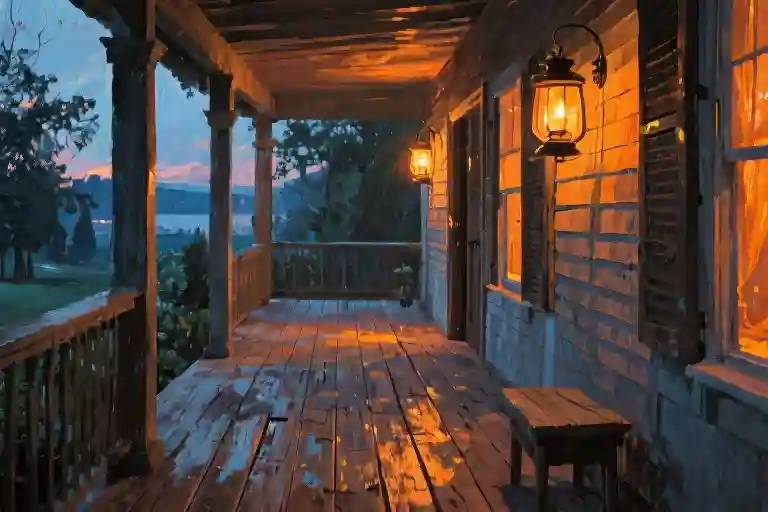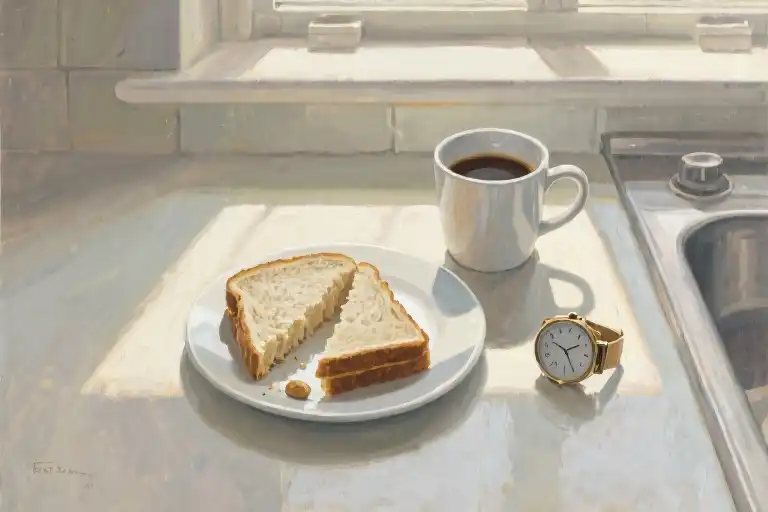The amber glow from swaying lanterns traced uncertain borders in the twilight, their light catching the edges of cotton dresses and rolled-up sleeves. Cicadas hummed in the distance—not an interruption, but another layer to the quiet between us. This was the kind of silence that felt deliberate, where even the brush of fabric against skin became audible.
Summer evenings have a particular weight to them. The wooden floorboards beneath bare feet still held the sun’s warmth from earlier, radiating it back now that the air had cooled. You could measure the day’s passage by how those planks gradually lost their heat, much like the horizon clinging to the last blush of daylight long after the sun had dipped below the meadow.
What fascinates me about writing atmospheric scenes isn’t just the visual details—the way lantern light picks up the sheen on someone’s forearm or how shadows make hair appear darker than it is. It’s how environment becomes an active participant in the story. That faint breeze moving through loose cotton isn’t merely describing a dress; it’s recording the tension between two people sitting close enough to share body heat without touching.
The best sensory writing operates on this dual level. The cicadas aren’t background noise—they’re the sound of waiting. The frayed leather bracelet isn’t just a fashion choice; its worn edges suggest years of being handled, turned over in moments of uncertainty. When his thumb taps against his knee in that old nervous habit, the rhythm syncs with the lanterns’ sway overhead, though neither acknowledges this connection.
This is where ‘show don’t tell’ transforms from writing advice into emotional alchemy. Notice how no one states they’re apprehensive or attracted—the entire exchange lives in the space between what’s said (nothing) and what’s noticed (everything). The leather bracelet’s weathering, the way cotton lifts slightly in the breeze—these become the vocabulary of the unsaid.
For writers learning to craft this kind of scene, start with one sense and let it lead you to others. That residual warmth in the floorboards? It begins as touch but becomes memory. The lantern light isn’t just seen—it traces physical paths along skin and fabric, making visible the distance (or lack thereof) between bodies. Even silence gains texture when framed by cicada songs and the creak of swinging lantern chains.
The Twilight Stage: How Colors Tell Their Own Story
The horizon held onto the last blush of daylight like a secret too precious to let go, while the meadow below surrendered to deepening shades of blue. This quiet collision of warm and cool tones did more than mark the transition from day to night—it set the emotional coordinates for everything that followed.
Lanterns swayed overhead, their amber glow carving out intimate pockets of light in the gathering dark. Each movement sent ripples across the wooden floorboards, the light catching the grain of the wood one moment, tracing the curve of a bare foot the next. These weren’t just sources of illumination; they became silent narrators, reshaping the space with every pass of the evening breeze.
What makes this interplay of colors so potent isn’t just their visual contrast, but how they engage our instinctive associations. That fading blush on the horizon tugs at something primal—the human reluctance to let go of warmth, of connection. The blues of the meadow don’t simply represent night’s approach; they mirror the quiet melancholy that often accompanies intimate moments, when words feel either too heavy or too light.
The real magic happens where these color fields meet. Along that thin line where blush fades into blue, where lantern light battles the descending dark, we find the story’s emotional fulcrum. Notice how the warm tones cling to the human elements—the glow on skin, the amber reflections in hair—while the cool tones claim the impersonal world beyond the terrace. This isn’t accidental; it’s environmental storytelling at its most subtle.
And then there’s the movement. Static colors would simply decorate the scene, but these colors won’t stay still. The lanterns set everything in gentle motion, making the warm tones dance while the blues remain steadfast. This creates a visual tension that mirrors the human dynamic playing out beneath them—the flickering uncertainty against the solid weight of what remains unspoken.
For writers learning to harness atmosphere, the lesson here isn’t about listing hues like paint swatches. It’s about understanding how colors behave when they interact—how they push and pull against each other, how they change depending on what stands beside them. That blush on the horizon would mean nothing without the blue to contrast against it; the lantern light loses half its power without the darkness waiting just beyond its reach.
Body Language: The Unspoken Dialogue
The cotton dress moved with the breeze, its loose fabric brushing against bare knees in a rhythm that felt careless and free. On the other side of that quiet space, his rolled sleeves stayed precisely where he’d folded them—two neat turns of charcoal fabric resting at mid-forearm, crisp enough to suggest intention rather than convenience. Between these two choices of fabric and fit, an entire conversation unfolded without words.
Material speaks volumes when we let it. The way my dress caught the air had nothing to do with the night and everything to do with how little I considered what might be seen or touched. His sleeves, though—those careful folds held stories in their creases. Some people roll their sleeves to work; others do it to remember they’re still capable of work. The difference lives in the tension of the fabric, in whether the folds look lived-in or freshly made.
Heat traveled between us without permission. Not the sticky warmth of summer air, but the particular radiance that comes from skin held close but not touching. His forearm rested near mine on the wooden bench, close enough that I could feel the difference between the night’s coolness and the human heat coming off him in slow waves. We’d sat like this before, but never with this awareness of the space between—that fragile distance where attraction and hesitation meet.
Then there was the tapping. His right thumb against his knee, a quiet percussion against the background of cicadas. Two quick touches, a pause, then three slower ones. A nervous system’s Morse code repeating whatever message he wouldn’t—or couldn’t—say aloud. I’d noticed this habit years ago, back when we still filled silences with easy words. Now the pattern had changed, grown more insistent or maybe just more noticeable in the absence of other sounds.
Body language becomes its own dialect when people know each other well enough. The way he turned his wrist just so when lying, how my shoulders lifted half an inch when pretending not to care—these were phrases in a private language. That night on the terrace, with the lanterns painting our silence in gold, every movement became a sentence. The way I tucked my hair behind an ear only to have the wind undo it immediately. How his fingers paused their tapping when I shifted closer, then resumed at a different rhythm when I stopped moving.
What we didn’t do spoke loudest. No accidental touches disguised as reaching for the same glass. No brushing away imaginary lint from each other’s clothes. Just the heat, the tapping, and the careful maintenance of that fragile space between us—close enough to feel, far enough to pretend we weren’t feeling anything at all.
The Weight of Objects
The leather cord around his wrist had that particular kind of wear that comes only from years of friction against skin. Frayed at the edges where it rubbed against watch straps or table edges, the darkened strands told stories no biography could capture. This wasn’t the pristine craftsmanship of a new bracelet bought for aesthetic appeal—it was an artifact of living, its very deterioration marking the passage of time more accurately than any calendar.
I found my eyes tracing its uneven surface, noticing how some strands had split while others clung together stubbornly. The way it moved with his gestures suggested it had long ceased to be an accessory and had instead become part of his anatomy. There’s a quiet intimacy to objects that survive our personal histories—they become witnesses to our private transformations, their physical changes mirroring our invisible ones.
Beneath my bare feet, the wooden planks retained the day’s warmth like a secret. That peculiar quality of wood—how it absorbs heat gradually and releases it reluctantly—made me think of memory itself. The way certain moments embed themselves in us, not with the sharp immediacy of metal or the fleeting coolness of stone, but with this same lingering persistence. My toes curled against the grain, feeling every ridge and valley as if reading braille.
Neither of us spoke about these objects that had become silent participants in our evening. The bracelet with its untold stories, the floorboards holding sunlight long after dark—they formed a vocabulary of their own, one that required no translation. In that suspended moment, I understood how the things we carry often speak louder than the words we choose.
This is the power of symbolic objects in storytelling: they allow emotions to manifest physically without the clumsiness of explanation. The frayed edges of that leather cord suggested devotion or perhaps stubbornness; the warm wood underfoot whispered of comfort and familiarity. When words fail or feel excessive, these tactile details become our most honest narrators.
Notice how the most mundane items can transform into emotional landmarks when given context. That’s the alchemy writers strive for—taking the ordinary and revealing its latent significance through careful observation and patient accumulation of detail. The key lies not in inventing dramatic props, but in recognizing the inherent drama of real objects that have weathered real lives.
The cicadas stopped mid-song. That sudden absence of sound made the space between us feel heavier, as if the air had thickened with all the words we weren’t saying. My bare feet still pressed against the sun-warmed floorboards, but the heat seemed to fade with each passing second, like the day itself was holding its breath.
This is how atmosphere works in writing – not through grand declarations, but through these tiny fractures in the expected rhythm. When an environment shifts unexpectedly (a silenced insect chorus, a lantern’s flame guttering out), it mirrors the unspoken tensions between characters. The technique works because it bypasses the conscious mind and speaks directly to our nervous systems; we’ve all experienced how a power outage or sudden rainfall can alter a conversation’s trajectory.
Notice how the original scene built its emotional tension through accumulation: the brush of cotton against skin, the barely-there warmth from his arm, the frayed leather bracelet that hinted at stories untold. The ending works because it violates that established pattern. After pages of gentle sensory details, the abrupt cessation of sound becomes a narrative event in itself.
Try this in your own writing:
- Establish a consistent environmental rhythm (wind in trees, clock ticking, coffee machine hissing)
- Let characters interact within that rhythm until readers absorb it as background
- Break the pattern at a key emotional moment – but subtly. A clock stopping matters more than a thunderclap
The best atmospheric writing doesn’t announce its symbolism. That vanished cicada chorus? It could mean fading summer, lost chances, or simply that the night grew too cool for insects. The ambiguity is what makes it linger.






Thank you for helping out, superb info. “The health of nations is more important than the wealth of nations.” by Will Durant.